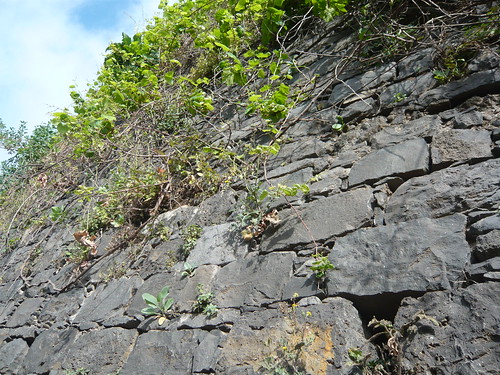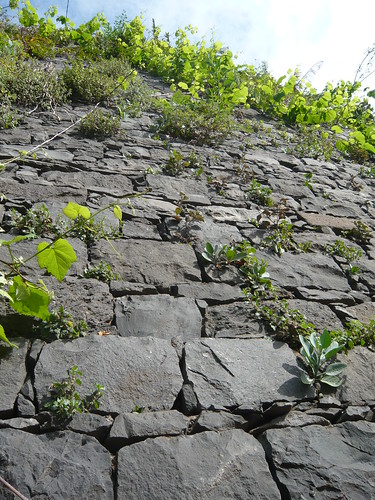Dry Stone Wall Planting
Crevice gardens are all the rage at the moment. The careful alignment of rocks can create some interesting locations for alpine and rockery plants. They are also very good for helping wild life to thrive.
See pictures of the Alpine Garden society rock supplier.
Other crevices can arise naturally or be created in the environment. These very high retaining walls are on a roadside but have been left like a dry stone wall. Rubble and soil are piled inside the stone which has been cut and faced. Between the stone a variety of plants are colonising the area.
You can create your own dry stone wall or crevice garden from a stone and a bank of soil.
Features of a Dry Stone Wall.
- Water runs freely through the retaining wall and is not trapped on the leaves of plants that are susceptible to rot.
- The soil is often poor in nutrients and is attractive to plants that thrive on those conditions.
- Moss and lichen will colonise the damp shaded places but in the full sun other plant variety will grow.
- Parts of the wall will be hot and dry so the plant selection should bear these conditions in mind.
- Insects and birds can use dry stone wall for food and shelter. Leave some uncut grass at the foot of the wall
- Height is not crucial but the wall needs to be at least a foot thick.
- Local rocks are best and will dictate the ph of the conditions.
Showstoppers for Nooks and Cranies.
- Rock jasmine (Androsace sarmentosa) A popular Himalayan species with grey, woolly rosettes that spreads slowly to hang over rocks; covered with carmine flowers in May.
- Woodruff (Asperula gussonii) Mounds of dense, silver-frosted, dark green leaves; stemless pink flowers in late spring or early summer.
- ‘Dickson’s Gold’ campanula (C. garganica ‘Dickson’s Gold’) Outstanding for its bright gold foliage, it also has light blue, star-shape flowers in summer.
- Rock stork’s bill or heron’s bill (Erodium petraeum spp. crispum) Although delicate in appearance with its lacy foliage, this erodium prefers full sun, wind and rocks. Flowers are white with dark purple veins; blooms non-stop from June to October.
- Siskiyou bitterroot or siskiyou lewisia (Lewisia cotyledon) Wonderful, succulent rosettes with a long succession of shades of pink to red-orange in late spring to early summer.
- Linum hirsutum This new flax has woody stems clothed in soft, hairy leaves. Large amethyst flowers are produced from July until frost.
- ‘Airemist’ primula (Primula allionii ‘Airemist’) A new alpine primula that has compact, delicate-toothed leaves with large, stemless flowers of purest white in early spring.
- Veronica bombycina A mat-forming, stunning plant with tiny, silver-felted leaves; covered with pure blue flowers in May.
Plant selection from Wild about Gardens
- Erysimum cheiri (Wallflower)
- Centranthus ruber (Red valerian)
- Aubrieta
- Arabis alpina subsp. caucasica (Rock cress)
- Aurinia saxitalis (Gold dust)
- Campanula carpatica
- Cymbalaria muralis (Ivy-leaved toadflax)
For a bit of fun read Copper Beech Hedges
Green Garden Habitats



2 thoughts on “Dry Stone Wall Planting”
I have noticed that those rocks seem to compose a good look around plants and wildlife. I never really thought of making a garden design based on these rocks. I am sure to use this for future reference! Thanks for the advice on planting.
Comments are closed.